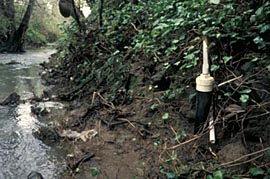Thirty, forty years ago, there were many more steelhead trout-and coho salmon too-in the Corte Madera Creek watershed than are seen today. There are many reasons for the decline, but without sufficient summer water flow, improvement in other areas will do little good.
The natural summer water supply for our creeks depends upon the discharge from soil saturated by winter rain, and when this flow is reduced by residents and businesses withdrawing water from the creek to water their landscaping, fish and other aquatic life die from lack of oxygen and food, from predation and from over-warm water. More than forty of these 5/8″ to 1-1/2″ pipes were recorded during a state agency survey in the Ross Valley. Summer low flows for Corte Madera Creek have been estimated at 450 gallons per minute; so if 45 residents were to run small pumps at ten gallons per minute on a Saturday afternoon, theoretically they would suck the creek dry and kill all fish.

Well head in Fairfax. Photo by Lou Vaccaro
Creekside landholders in California may, in general, exercise their riparian rights to use water from the creek. However, the state Constitution and Water Code require that: riparian users do not waste water; they do not store water for more than 30 days; available water is shared among riparian users; and Statements of Use are filed every three years with the State Water Resources Control Board. Recent legal developments have established that just as watering a garden is a “beneficial use” of water, supplying the needs of aquatic and riparian wildlife is also a beneficial use of water, and thus any water withdrawal must not be at the expense of wildlife. Creeks are held in public trust by the state of California, and are regulated in the public interest.
The use of publicly provided water and the planting of less water-consumptive gardens and landscaping are clearly the best way to protect our creeks.
